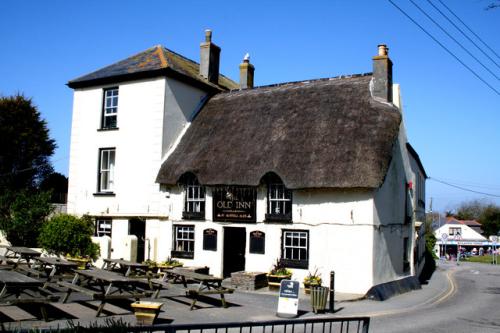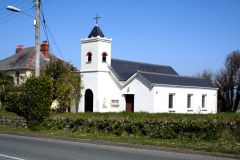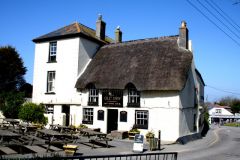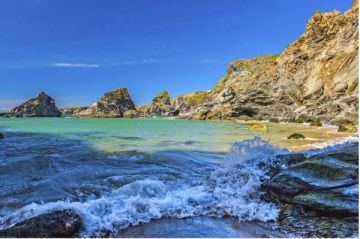
Mullion is the largest village in the Lizard peninsula of southern Cornwall. The nearest major centre is the town of Helston, about 5 miles away. The most historic building in Mullion is the 13th-century church of St Mellanus, which boasts richly carved bench ends depicting scenes from the Bible.
The 13th-century south door features a 'dog door' set into it to allow canine visitors (worshippers?) to enter in. The north door is perhaps even more historically important; it is held together with wooden pegs and may date to the 11th century. The nave roof is said to have been made with timbers from Goonhilly Forest, which covered Goonhilly Downs during the late medieval period.
The village used to be called Mullion Churchtown, but is now called simply 'Mullion'. It takes its name from St Melaine, 6th century Bishop of Rennes, though another tradition suggests that it was instead the Welsh saint Malo. In the 19th century, an ancient chapel stood on a spot known as St Malo's Moor, so thee may be some truth in the tradition.
Mullion Cove is one of the prettiest in Cornwall and has been purchased by the National Trust to preserve it for future generations to enjoy. The Trust also owns Mullion Island, about 0.5 miles offshore, notable for its large colony of seabirds.
The Cove has a working harbour, sheltered by a seawall. The harbour was built in 1895 when the area was a centre of the pilchard fishery. Remnants of the heady days when pilchard fishing brought prosperity to the area can still be seen in the net store and pilchard cellar where the fish were stored. Of course, this being Cornwall, smuggling rivalled fishing as an occupation for the locals!
This stretch of coastline was notoriously difficult for mariners, so Mullion Cove maintained a lifeboat station from 1867 until 1901. Curiously, Mullion Cove is not the closest beach to the village; that honour goes to Pollurian Cove, reached by a footpath along the cliffs.
Mullion also holds a place in the history of wireless communication, for it was at nearby Poldhu that Marconi sent the first transatlantic wireless signal in 1901.
The village lies within the Cornwall Area of Outstanding Natural Beauty (AONB), and Mullion Cliff is home to 10 rare plant species.
As the largest village in the Lizard peninsula Mullion is a popular tourist destination, with shops, restaurants, even a golf course to serve visitors.
About Mullion
Address: Mullion,
Cornwall,
England
Attraction Type: Village
Location map
OS: SW680189
Photo Credit: Dr Neil Clifton, licensed for reuse under a Creative Commons Licence
HERITAGE
 We've 'tagged' this attraction information to help you find related historic attractions and learn more about major time periods mentioned.
We've 'tagged' this attraction information to help you find related historic attractions and learn more about major time periods mentioned.
Historic Time Periods:
Find other attractions tagged with:
11th century (Time Period) - 13th century (Time Period) - 19th century (Time Period) - 6th century (Time Period) - Medieval (Time Period) -
NEARBY HISTORIC ATTRACTIONS
Heritage Rated from 1- 5 (low to exceptional) on historic interest
Mullion, St Mellanus Church - 0.2 miles (Historic Church) ![]()
Gunwalloe, St Winwaloe's Church - 1.6 miles (Historic Church) ![]()
Bonython Estate Gardens - 1.8 miles (Garden) ![]()
Halliggye Fogou - 3.7 miles (Prehistoric Site) ![]()
Mawgan Cross - 4 miles (Prehistoric Site) ![]()
Mawgan-in-Meneage Church - 4.2 miles (Historic Church) ![]()
Landewednack, St Wynwallow's Church - 4.4 miles (Historic Church) ![]()
Helston Museum - 5.5 miles (Museum) ![]()






